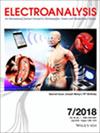Evaluation of the antibacterial activity of antibiotics with different antibacterial mechanisms using electrochemical signals of heat‐treated Escherichia coli
IF 2.7
3区 化学
Q2 CHEMISTRY, ANALYTICAL
引用次数: 0
Abstract
Electrochemistry with purines as indicators may be a promising new method for antibiotic activity testing. However, the traditional electrochemical detection method (S‐LSV) requires a long accumulation time for purines and has low signal intensity. High‐temperature treatment of bacterial samples may significantly enhance the signal intensity and speed of detection. However, this process may also impact the structure and metabolism of bacteria. Further research is necessary to determine how electrochemical signals respond to antibiotic antibacterial activity. In this paper, the electrochemical detection method based on heat‐treated Escherichia coli ( <i>E. coli</i>, H‐LSV) was used to investigate the利用热处理大肠杆菌的电化学信号评估具有不同抗菌机制的抗生素的抗菌活性
以嘌呤为指示剂的电化学方法可能是一种很有前途的抗生素活性检测新方法。然而,传统的电化学检测方法(S-LSV)需要较长的嘌呤积累时间,且信号强度较低。对细菌样品进行高温处理可大大提高信号强度和检测速度。然而,这一过程也可能影响细菌的结构和新陈代谢。要确定电化学信号如何响应抗生素的抗菌活性,还需要进一步的研究。本文采用基于热处理大肠杆菌(<i>E. coli</i>,H-LSV)的电化学检测方法来研究抗生素抗菌活性对细菌的影响。
本文章由计算机程序翻译,如有差异,请以英文原文为准。
求助全文
约1分钟内获得全文
求助全文
来源期刊

Electroanalysis
化学-电化学
CiteScore
6.00
自引率
3.30%
发文量
222
审稿时长
2.4 months
期刊介绍:
Electroanalysis is an international, peer-reviewed journal covering all branches of electroanalytical chemistry, including both fundamental and application papers as well as reviews dealing with new electrochemical sensors and biosensors, nanobioelectronics devices, analytical voltammetry, potentiometry, new electrochemical detection schemes based on novel nanomaterials, fuel cells and biofuel cells, and important practical applications.
Serving as a vital communication link between the research labs and the field, Electroanalysis helps you to quickly adapt the latest innovations into practical clinical, environmental, food analysis, industrial and energy-related applications. Electroanalysis provides the most comprehensive coverage of the field and is the number one source for information on electroanalytical chemistry, electrochemical sensors and biosensors and fuel/biofuel cells.
 求助内容:
求助内容: 应助结果提醒方式:
应助结果提醒方式:


